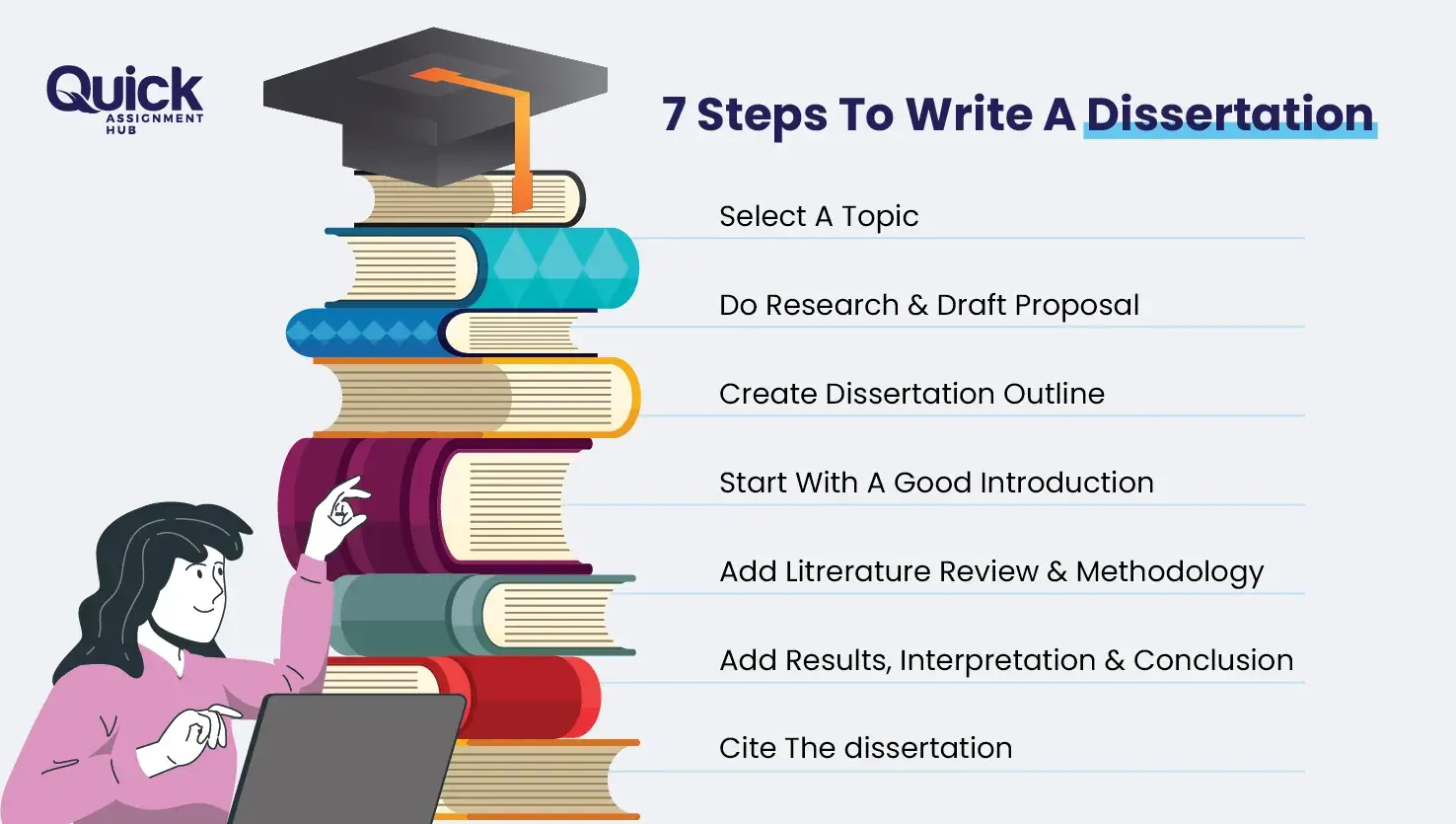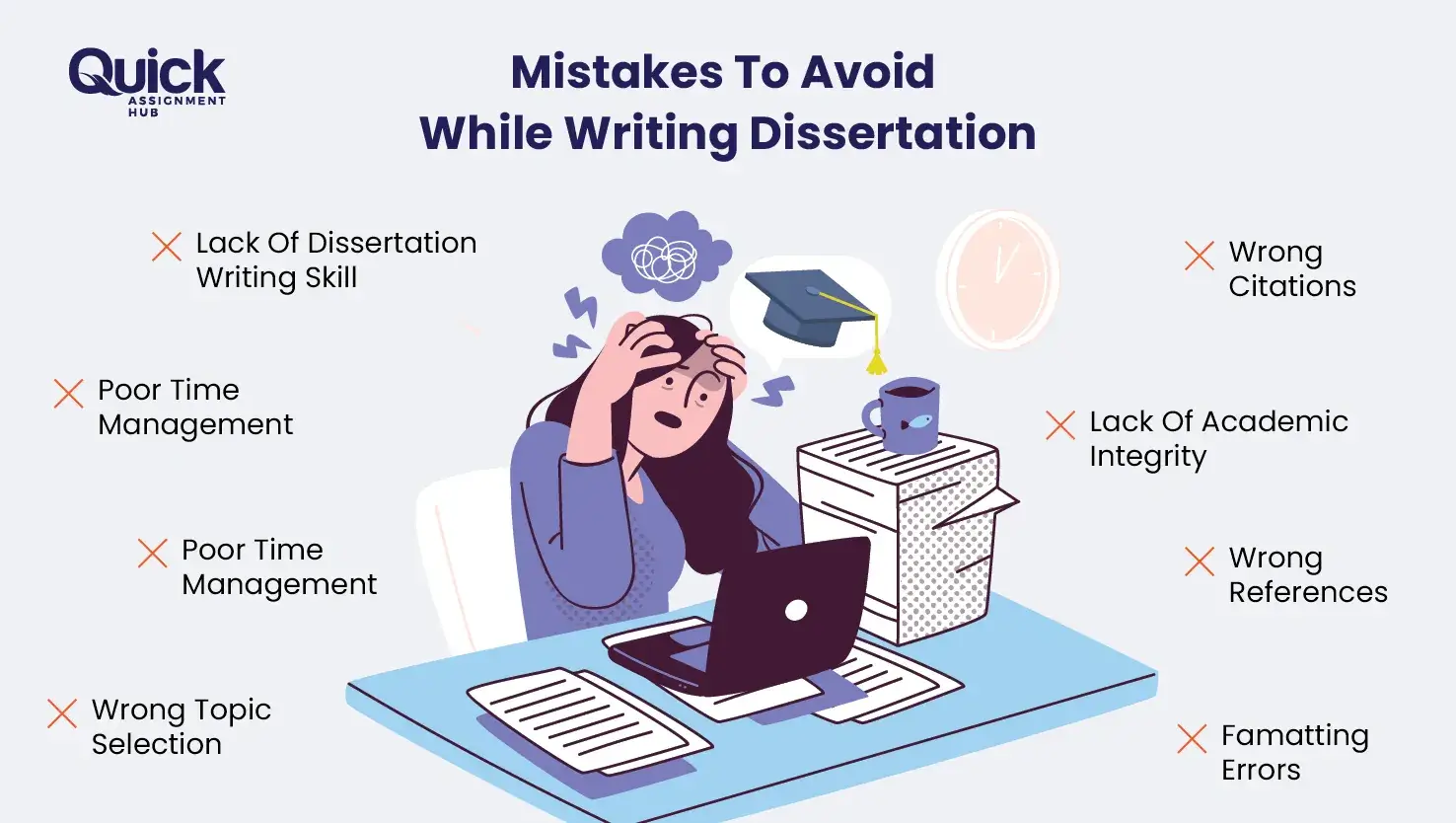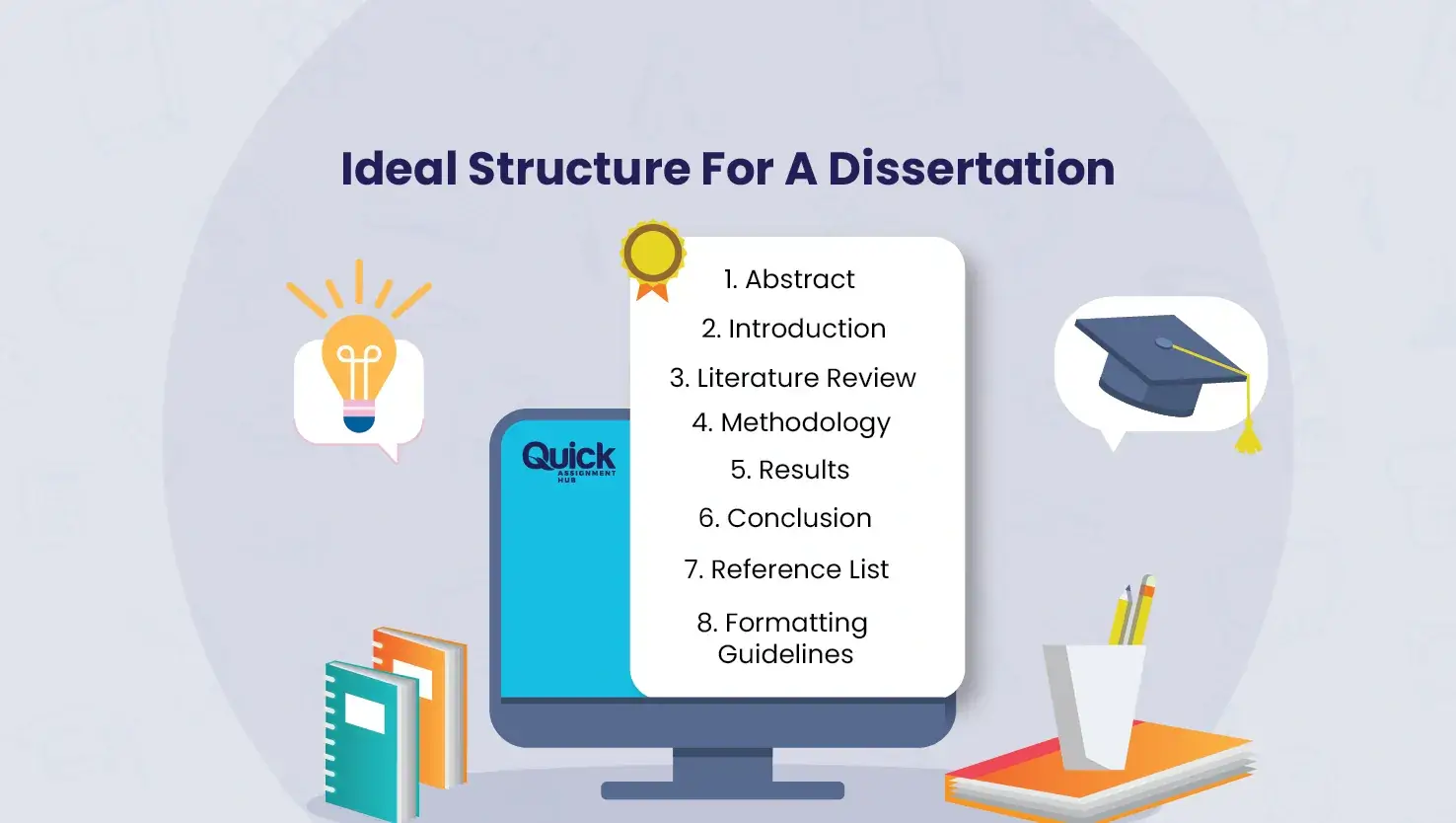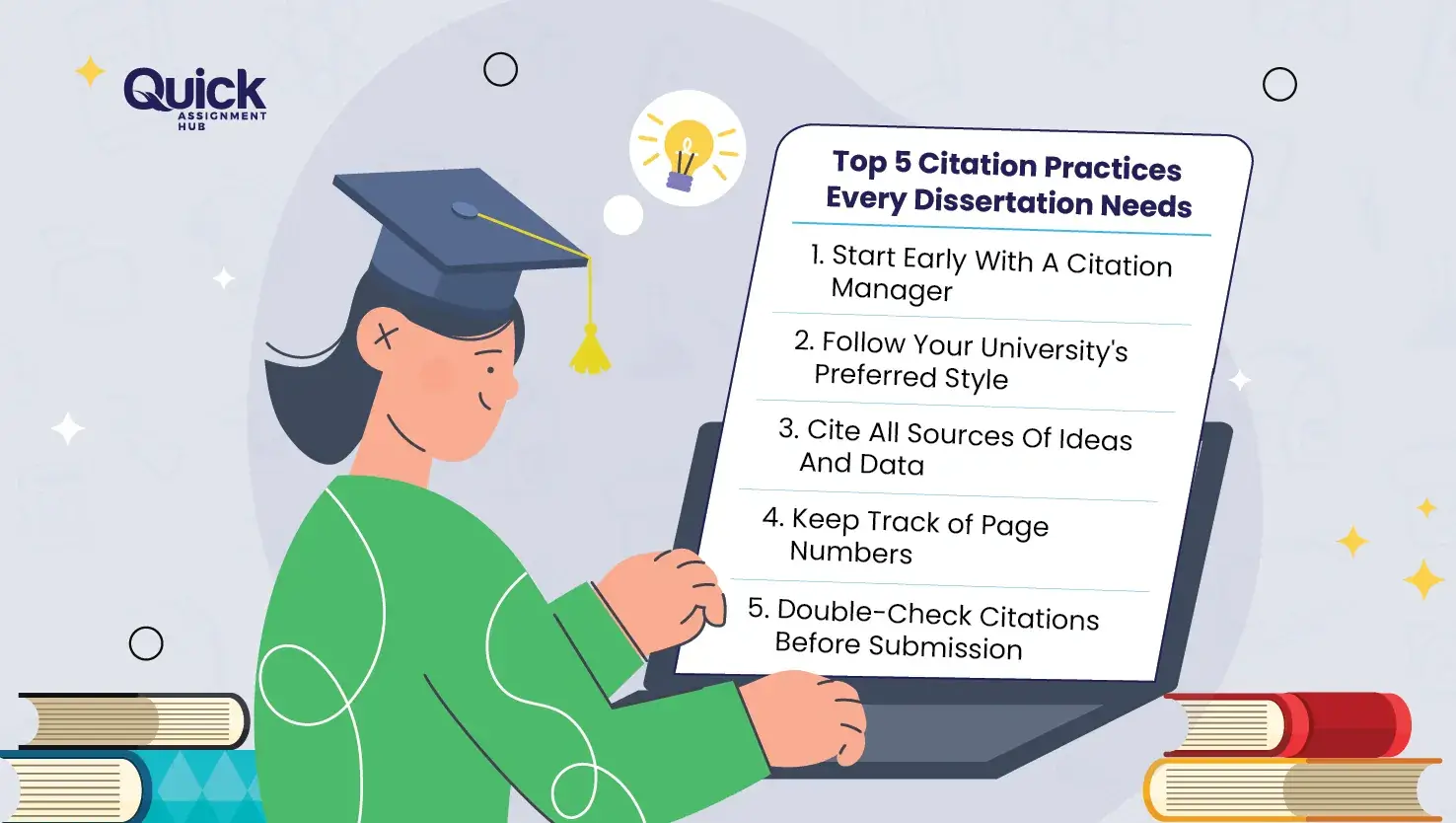
Being bogged down while writing a dissertation? You are not the only one. Studying in the UK, you know that writing a dissertation is the most critical and important task in your academic career. It can give a new direction and high to your career growth.
So, you must be meticulous when writing your dissertation to meet your professor's expectations. This blog will cover all essential areas of how to write a dissertation from start to finish. Consider this your guide on how to write a dissertation that stands out. Don't delay any further, just dive to get to know the right way forward, using clever approaches and effective methods to get your dissertation writing on track.
To know how to write a dissertation, you first need to understand what a dissertation is. A dissertation can be considered independent and substantial research that students have to carry out in their academics, especially for their undergraduate or postgraduate courses.
As your primary query is "how to write a dissertation, " you must do rigorous research systematically and write it according to the dissertation format shared by the university. The logical sequence of your research becomes evident through your dissertation, which elevates your credibility as a UK student. Most importantly, completing your university degree is the apex point and helps you get high marks during the final grading.

As it must be clear what a dissertation is, let's move to the next step of learning "how to write a dissertation". This step is more important; hence, you must focus on why it matters the most. A dissertation holds utmost importance in academics as it is recognised as a significant piece of professional academic writing. It helps professors determine how students are proficient in conducting research, presenting findings, analysing data and information and writing them strategically.
Dissertation writing in UK demonstrates your ability to be a world-class scholar or researcher. A good dissertation shows that you are ready to take your research area to the next level. With dissertation writing, you can showcase your prominent research skills and how effectively you can address a topic or issue for a greater purpose. It encourages students to foster independent inquiry to cross an academic milestone. UK universities look at the dissertation as a tool to nurture intellectual development and growth.
Choosing the right dissertation topic is integral to your dissertation writing process. Below are a few steps that will help you understand how to write a great dissertation topic:
In the third step of your question, "How to write a dissertation", is to go through the dissertation topic selection process. The selected topic will reflect your core interest in the subject and what drives you forward in your research journey. A valuable tip for dissertation writing is that you must be careful when choosing a topic, as it should align with your expertise and future goals.
University dissertations UK also require choosing a topic relevant to the dissertation questions, social perspectives, and doctoral research. A well-defined topic for a dissertation is essential for research feasibility. This also means that there are sufficient sources of information already present in existing literature by different authors, and you can contribute to it for further study. This critical aspect of the dissertation topic will help you reach your research goals more effectively. That is why it is essential to understand how to write a dissertation.
Moreover, choosing the right topic for your dissertation that intrigues your interest can help you stay motivated to finish the dissertation more efficiently. A topic you are well aware of will help you research more profoundly and thus write about it more easily.
A dissertation proposal holds significant weight in a dissertation. A dissertation proposal is the first document that is shared with the professor. This document sets the tone for your complete dissertation. Let's learn how you can create a compelling proposal:
The answer to the question"how to write a dissertation" is not complete without knowing how to write a dissertation proposal for your dissertation. To write a dissertation proposal, you must include a Title, Synopsis or Abstract, an Introduction, a Literature Review, a Methodology, Aims and Objectives, a Timeline, Research Contribution, correct references, Ethical Considerations, Potential Limitations, and the overall Budget. As per University Dissertations UK suggestions, dissertation proposals are essential, giving a brief overview of the expected research progress and the outcomes.
In the introduction, you must explain your research problems and state how you will proceed. As per the tips for dissertation writing, you can include possible research gaps and critically analyse existing academic papers in the literature review. Furthermore, in methodology, you can provide details on research design, data collection methods, and data analysis techniques. With this information, the answer to the question "how to write a dissertation" is getting clearer.
For a scoring dissertation proposal, as per dissertation advice UK, you need to propose the aims of your research from a broader perspective. More precisely, you should demonstrate what you are willing to achieve. To define the objectives, outline all measurable actions that will help you reach your aims. It is more focused on the purpose and goal of your research for writing a dissertation.
The rationale of your dissertation proposal writing is to justify your chosen topic and its logic. As dissertation advice UK proposes, a research rationale also highlights why your research is essential and how it appropriately addresses current knowledge and study gaps. A correct understanding of your aims, objectives, and rationales builds the foundation of learning how to write a dissertation.
The 5 most common challenges associated with how to write a dissertation have been discussed here. Read on to learn about the inevitable issues that can arise while writing a dissertation, and how you can successfully tackle them. And if you want to know how to overcome these hurdles effectively and how to write a great dissertation, then check the list below:
Refine your dissertation question to make it evident in your dissertation. Failing to define research questions properly can lead to vague dissertations and result in poor marks. The dissertation writing guide recommends always aligning the research questions with the answers and addressing them with appropriate measures.
Not having a detailed enough literature review makes your dissertation weak. So, you should use academic databases like Google Scholar, JSTOR or PubMed to gather information and state their contribution to your field of study. Adding a systematic literature review will also contribute to a strong dissertation.
As per the Dissertation Writing Guide, there is a high chance that you might not be able to finish your dissertation on time without proper time management skills. Moreover, a dissertation demands adequate time to research and write it accordingly. You can create a schedule for writing your dissertation and allot a specific time in the timetable for each chapter so that you can finish your dissertation within the due date.
Each university shares some specific guidelines for the dissertation. These guidelines include format, word count, referencing style, and marking criteria. Failure to maintain these dissertation formats and guidelines can make your dissertation appear unprofessional, which may result in a lower score. So, you must read your academic instructions carefully and polish your dissertation by formatting and editing it. Always double-check your dissertation before submission in order to avoid the most common mistakes in dissertation writing that students often ignore.
A weak thesis statement, if not properly crafted, can steal the limelight from your dissertation. So, brainstorm different and unique ways to formulate a strong thesis statement that reflects your main ideas of the dissertation. Write a focused and concise thesis statement to re-establish the research purpose. Make sure to stick to the word count limit for the thesis statement shared by the university.

To ensure the timely completion of any task, planning is very important. When it comes to dissertation writing, the importance of planning increases. When tackling the question of how to write dissertation, planning is the road map that will take you to a higher-scoring dissertation. A few tips are listed below to help you plan better.
Create an outline and produce a layout with the core questions. Dissertations are usually between 8000 words and 15000 words, so dividing them into sections would be the best approach. Prepare a timeline of the major sections in your dissertation, including numbering and addressing chapters, to carry out your research. Arrange them in chronological and systematic order. Breaking down your dissertation will help you do your research efficiently, and you can track your progress easily. With the layout, you can divide the word counts further in reasonable measures. Following this outline of your dissertation, you can estimate how much time you will need to complete it.
Take help from the research tools that can help you manage information, take notes, and plan out your dissertation. Some significant tools that can be handy for your research process are Trello, Notion, Asana, Genei, Zotero, Mendeley and Google Docs. These tools can help you efficiently write literature reviews, thesis management requirements and academic writing. You can manage all your tasks seamlessly with these tools. Moreover, you can also switch to the timeline view of these tools to see the calendar and add a deadline. These AI tools will guide you through your research and writing and answer your questions more efficiently.
A dissertation is much more than just a lengthy assignment. It is an academic document that will define your future career paths. Hence, to make sure you give your 100% to dissertation writing, time management is a vital factor. One small mistake can change your image from a good researcher to an average writer. To make sure you do complete justice to your dissertation, you must allot specific research time and writing each section. Follow a timetable and stick to the timeline for a better dissertation outcome. Allocate particular time to research each section and write it, and try to stick to that time frame. While planning, keep sufficient time for writing, revision, editing and proofreading.
When it comes to dissertation writing, research is the most essential part. A good dissertation is a perfect combination of meaningful research and a well-written document. In this information overload era, researching can be a tricky task. Learning about different research methods and approaches will help you solve your particular query about how to write a dissertation. For better understanding, we have discussed a few of the methods below:
The main difference between primary and secondary research is that primary research involves acquiring new information or data from the data collection procedures you conducted. In contrast, secondary data involves utilising existing data or information from sources that others have already collected.
Primary research is undoubtedly a time-consuming process. However, secondary data is easy to obtain and a cost-effective solution. Secondary research can present a broader view of a trend in a topic, whereas primary research conveys unique insights that directly relate to the particular research questions. You need to understand these differences between primary and secondary research to know how to write a dissertation.
Qualitative Approach: In qualitative research for a dissertation, you must define the process of understanding various social phenomena, experiences and perspectives of individuals or groups. For this purpose, you can opt for various research tools like surveys, interviews, case studies and focus groups. Moreover, you must analyse participants' views, reactions, and beliefs to draw your interpretation and results.
Quantitative Approach: In Quantitative Research, qualifying the variables, including opinions, attitudes, and behaviours, is the main objective. A generalised result can be produced based on this type of research, which helps you craft essential outcomes for your dissertation. Different methods associated with this type of research are experiments, observations, and document reviews. If you want to know how to write a dissertation, you must clearly understand these research approaches.
Mixed-Method Approach: The mixed-method research approach is a combination of both qualitative and quantitative research. If your dissertation demands more flexibility to collect data and run your analysis, this research approach suits you. You have to integrate qualitative and quantitative data, which further adds to the strength of your research. It is the most preferred method of addressing research questions comprehensively.
Dissertation research ethics play a vital role in determining the research strategy you want to carry forward to write your dissertation. You need to consider the ethical requirements of the UK, such as aiming for beneficence and avoiding harm.
Some of the most practised principles in ethical guidelines regarding participants in your research are :
Providing the right to withdraw,
Refraining from deceptive activities,
Obtaining consent,
Maintaining confidentiality of information and protecting anonymity, and
Minimising the risk of harm.
These principles hold utmost importance for both ethical reasons and to incorporate practicality into your research.
Ethical guidelines re-establish the significance of showing and having respect while still contributing to the greater aspect of any field of study. However, if you fail to maintain ethics in your research, the university might reject your dissertation. As per the UK university criteria, you may also need to write an Ethics Proposal or Consent Form. It is a crucial part of acquiring a solid understanding of how to write a dissertation. For a better understanding, talk to your professor regarding the ethical requirements of your dissertation.
Structuring a dissertation according to the UK university standard ensures that your dissertation gets approved by your professors quickly. So, check out the Standard UK Dissertation Format Overview below:

Title Page: Design your title page with authentic information associated with your respective university, like the dissertation title, your name, the name of your department and institution, the degree program, and the due date.
Abstract: An abstract serves the purpose of giving an overview of your dissertation. It concisely summarises dissertation problems, significant findings, methods and conclusion. The appropriate length of an abstract is within 200 words.
Table of Contents: The Table of Contents is a page that lists all chapter names and assigns specific page numbers to each. You need to place the table of contents between the abstract and the introduction. It is a list of all the chapters and subchapters in chronological order, along with the page number.
Introduction: A dissertation introduction is akin to a snapshot, including an opening section, research background, research aims, research objectives, research questions, and a glimpse of the final statement.
Literature Review: In the literature review, you need to evaluate each piece of literature you want to discuss and its contribution to your findings. You can include 5-7 literary works or more, depending on the guidelines, and provide a review of each.
Methodology: When submitting the proposal, you also need to highlight the methodology you will be following for the research of your dissertation. When writing the final dissertation, make sure to the follow the same methodology for data collection and analysis.
Findings/Results: In this section, you need to present your final thought and conclusions as clearly as possible. Addressing the findings is the key to writing a good dissertation. Adding tables and graphics to this section for an impressive look.
Discussion: Focus on creating arguments that support your analysis, research and literature review. Apart from finding your own thoughts are also very important for an impactful dissertation.
Conclusion: In the last chapter of your dissertation, you need to restate your dissertation, summarising the key points mentioned throughout your research. This is the final section of your dissertation, so make sure to keep it crisp and easy to read.
References: Add a reference list at the end of your dissertation as per the format shared by the university. The title of this page can vary depending on the university guidelines, such as in Harvard, you can write "Reference List", in MLA, the title should be "Works Cited", and in APA, it is "References".
Appendices: This section contains all supplementary materials that play a significant role in the main text's core arguments and are relevant to the research. Without disrupting the flow of information in the dissertation and without creating any distraction for the professor, you can add questionnaires, interview transcripts, detailed figures, lengthy tables, and raw data as appendices.
Planning your dissertation is a very important task. Since a dissertation is a lengthy task, proper planning well in advance is very crucial. You can use a Gantt chart to effectively plan your dissertation timeline. Let’s discuss briefly about a dissertation Gantt chart and how it helps to plan your dissertation timeline.
A Gantt chart is a graphical representation of a project, showing tasks in order, along with their start and completion dates. For the dissertation, it outlines the timeline for all steps of conducting research, from submitting the dissertation, and aids in streamlining the timeframe. It also demonstrates the length of each task and how each task corresponds to the other (e.g. what tasks can happen beside one another and what must be accomplished prior to others starting). The professor allocates separate marks for adding a Gantt chart in the dissertation. Some of the key elements of a dissertation Gantt Chart are:
Tasks: Definite steps to be followed in the dissertation (e.g. literature review, collection of data, writing certain chapters).
Timeline: Horizontal scale that reflects the time (days, weeks, months).
Bars: Each task is represented by a bar, the size of which corresponds to the estimated or actual time required for the task.
Dependencies: Task relationships, meaning which tasks must be completed before other tasks can begin.
Milestones: Important moments of the project (e.g., the delivery of the proposal, the provision of data analysis).
Progress Tracking: Some Gantt charts are designed to monitor the actual progress you are attaining in relation to the planned schedule, thus pointing out some possible delays or where your concentration should be.
Writing the chapters of a dissertation is an arduous task. You need to be cautious when writing each section with the correct information. Read on to learn more about what each section signifies, what to write in different sections, and how to write them appropriately.
As it is the first section of your dissertation, you need to hook your professor with a strong thesis statement that intrigues your research interests. Add a brief overview of the background of your research topic to provide context. Draw your professor's attention to how relevant your dissertation is to the existing study. Talk about the focus and the scope of your research. You also need to mention the different aspects and themes of the dissertation topic.
Conduct thorough research to select the research paper which to be added to the literature review section and how it is appropriate for your dissertation. State the findings and organise them accordingly. You also write about your critical analysis based on the significant points of the research paper. Pick a literature relevant to your research and dissertation topic and evaluate it logically. You must also mention the possible gap in the research paper where further research or study is needed. Dissertation writing help experts thoroughly read the existing literature, whether it is a journal article, an academic paper, a book, or a published article.
You need to select the proper method for the collection purpose and justify it, so the professor can understand why you chose that particular method for analysing your gathered data. Give details about your data collection methods and introduce your approach, whether a survey, an interview, an observation or an experiment. You also have to explain how you prepared your data properly. Moreover, you need to mention the sampling method and all the tools that help you accurately process your data.
In the results section of your dissertation, you need to present your data concisely. Ensure that you lay out all the analysis, along with any relevant graphs or tables. In particular, leave no room for assumptions. Blend your result skillfully with the research question, so that it prevails as the relevance factor. While writing this section, pick the border results and then create a flow through the less important ones.
As per dissertation writing in UK, in the discussion section, you are supposed to elaborate heavily on the results. You must interpret your findings and place them within context to further conclude your dissertation topic and research. More importantly, the discussion primarily reflects the unbiased nature of your research. You can also provide valuable recommendations in this part that lead other researchers to future work. However, be mindful not to make inflated claims in the discussion.
You must reflect and emphasise your dissertation process and wrap up your research intelligently in the conclusion. Moreover, clearly stating your findings in this last section will reassure your professor that you have done justice to your dissertation topic altogether. No new information should be included further in this chapter. Always be sure you add a clincher that is emotional and thought-provoking and leaves enough room for further studies.
Referencing a dissertation is the most crucial task for writing a dissertation. Find out the best referencing practices below and how to write them.

Use Correct Citations to Support Your Arguments: You have to use citations to validate your claims, arguments, discussion, or any central point in your dissertation.
Incorporate In-text Citations Accurately: Adding in-text citations requires mentioning the author's name and publication date. The right place to include an in-text citation is at the end of each sentence. For example - (Mark, 2025).
Following one particular citation style: Always be sure to use the right university referencing style, which can be MLA, APA, Harvard, or Chicago. Format your dissertation based on any one particular style. Follow only one referencing style throughout your dissertation.
Include a Reference List: At the end of your dissertation, list all the references you have used in your research. Create a separate page for the reference list and arrange all the references in alphabetical order.
What to Include in the Reference List: You can write citations for books, academic journals, published articles, tables, images, and websites. Each reference should include the author's last name, publication date, title of the work, source information, and URL.
For example - Ibrahim, A.U. and Daniel, C.O., 2019. Impact of leadership on organisational performance. International Journal of Business, Management and Social Research, 6(2), pp.367-374.
https://www.journalbinet.com/ijbmsr-060219-39.html
To make this task easier, you can use an online reference generator as well to get properly formatted references.
When discussing the process of how to write a dissertation, plagiarism is a serious concern. If it crosses the limit allowed by the university, it might lead to serious consequences. Read about different ways to ditch this problem in your dissertation writing.
Always cite your sources if you have used an author's idea. It can be a direct quote, argument points, theories, images, facts, or paraphrased information.
When researching, take detailed notes and distinguish your original thoughts from the source material.
Be sure you record all bibliographic information and keep track of sources in your research progress.
Use plagiarism-detecting tools like Turnitin to identify the plagiarised portion of your dissertation and make changes or rewrite it.
Harvard Referencing: Harvard referencing is the most commonly used referencing style in UK universities. You must include the author's last name, year of publication, and the page number from which you have extracted your information.
APA Referencing: The American Psychological Association (APA) is mainly used in business, psychology, education, health science, behavioural science, and social science. It is an author-date system where you can write your reference like (Peter, 2025). Here, the page numbers are optional.
MLA Referencing: Modern Language Association (MLA) uses author-page number. For example, (Peter, 95)
Before you submit your dissertation, be sure that you have a checklist to ensure that your dissertation is up to standard.
Proofreading: Pay attention to detail and detect grammatical, spelling or punctuation errors. It is an essential step to thoroughly proofread your dissertation.
Review Your Dissertation: Revise your dissertation to ensure the information is consistent and clear. Maintain a steady flow of writing to increase readability.
Editing: Check whether the word count has been maintained in your dissertation. Edit accordingly and rewrite if necessary.
Final Check: Polish your dissertation with extensive editing and refining. You can seek dissertation help for expert assistance on proofreading or even drafting the dissertation.
Your First Order
Get 20% OFF!
Be sure you have no language barrier and can write and express your ideas and thoughts eloquently in proper academic language. Moreover, you must write your dissertation by incorporating appropriate academic terms associated with your dissertation subject. Using academic terms and language will enhance your dissertation's flow and make it more professional.
The final step in writing an excellent dissertation is formatting it according to the referencing style as per university guidelines. Maintain a standard font style (Times New Roman) and font size (12 point) throughout your dissertation. Create headings and subheadings, making them bold. The alignment should be "Justified", and the spacing should be double. Depending on your university's dissertation requirement, you must also add a margin or border.
Now that you know how to write a dissertation, check out the key takeaways. You can now prepare a title page, write sections and chapters more proficiently, handle plagiarism issues, and format it accordingly to the university's requirements. To complete your dissertation within the deadline, be sure that you stay motivated and follow this blog's instructions accurately. This dissertation assistance is designed for students new to writing or trying to ensure their dissertation is up to standard. Hope this blog will sail smoothly through your dissertation.